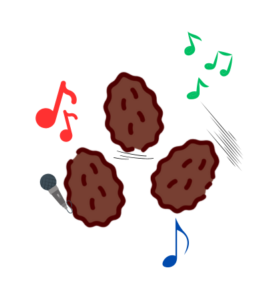
Dancing Raisins: The Spectacular Soda Symphony
Brief Description: Get ready to groove with your food! In this exciting science experiment, you’ll make raisins boogie up and down in a glass of soda. You’ll learn about gases, density, and buoyancy, and why these tiny dried fruits can dance!
Scientific Principles:
- Gas: This experiment will help you understand how gases in the soda react when they attach to the raisins.
- Density: You’ll learn why objects (like raisins) sink in water and why they rise when gas bubbles stick to them.
- Buoyancy: When gas bubbles attach to the raisins, they become less dense and start to float. This shows the principle of buoyancy.
Equipment Needed:
- Clear glass
- Soda water or any clear carbonated drink
- Raisins
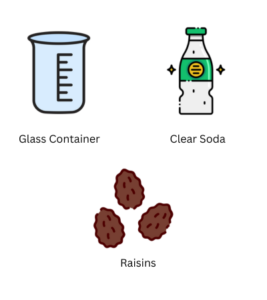
Equipment Difficulty Rating: 1 – All you need are common household items or simple grocery store purchases.
Experiment Difficulty Rating: 2 – This experiment is easy and safe for kids to perform with a little adult supervision.
Instructions:
Step 1: Gather Your Materials Find a clear glass, some raisins, and soda water. We use a clear glass so that you can watch all the action happen! Place everything on a table where you want to do your experiment.
Step 2: Fill the Glass Open the soda water (you might need to ask an adult to help you with this part). Pour the soda water carefully into the glass until it’s about three-quarters full. Watch out for the fizz!
Step 3: Drop in the Raisins Now, let’s make the raisins dance! Take three or four raisins and drop them into the glass. They will sink to the bottom—that’s normal!
Step 4: Watch the Magic Here comes the fun part. Watch closely! Soon, the raisins will start to move up towards the top of the glass. That’s them starting to dance!
Step 5: Keep Observing But wait, the dance isn’t over. Once they reach the top, the raisins will fall back down again. Why do you think that happens?
Step 6: Think About What You’ve Seen The raisins keep moving up and down, almost like they’re dancing in a soda symphony. Can you think of why this might be happening? (Hint: It has to do with the bubbles in the soda!)
Simple Explanation:
You know how in a swimming pool, a big heavy ball sinks but a light beach ball floats? That’s because of something called “density” – how much “stuff” is packed into an area. Now, in our experiment, the raisins are like the heavy ball – they’re denser than soda, so they sink to the bottom.
But here’s the cool part! The soda water has lots of tiny bubbles of gas (that’s what makes it fizzy). These bubbles stick to the raisins and make them “lighter” or less dense, just like a beach ball. That’s why the raisins rise to the top! Once they’re there, the bubbles pop, and the raisins become “heavy” again and sink, and then the whole dance starts over!
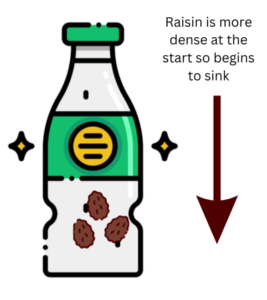
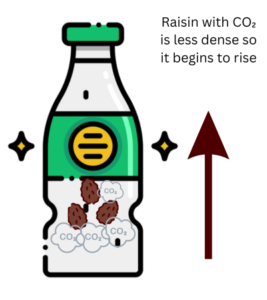
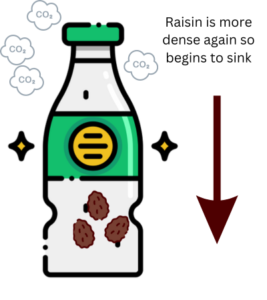
Detailed Explanation:
In this experiment, we’re observing the principles of density, buoyancy, and the behavior of gases in liquid.
Let’s start with density. Density is the mass of an object divided by its volume – in simple words, how much “stuff” is packed into a certain space. Raisins are denser than soda water, so they sink to the bottom of the glass when you first drop them in.
However, soda water is a carbonated beverage, meaning it’s filled with lots of tiny carbon dioxide gas bubbles. This is what gives soda its fizzy characteristic. When you drop the raisins into the soda, these gas bubbles attach to the rough surface of the raisins.
Now, we come to buoyancy. Buoyancy is the force that helps objects float in a fluid (and yes, scientists refer to both liquid and gas as “fluid”). The attached gas bubbles decrease the overall density of the raisin (it’s like the raisin plus the bubbles become a bigger, lighter object). Because the raisin is now less dense than the soda, it floats to the top due to buoyancy.
But the dance doesn’t end here. Once the raisins reach the top, the gas bubbles escape into the air (this is because gas always moves from areas of high pressure – the soda – to areas of low pressure – the air). Without the gas bubbles, the raisins become denser than the soda again, and they sink to the bottom, only to start the dance again as more gas bubbles attach. And so, our Spectacular Soda Symphony continues!

